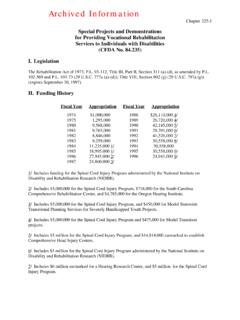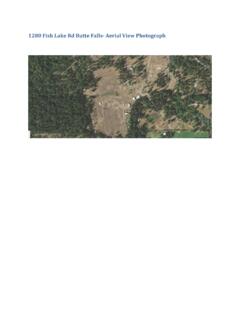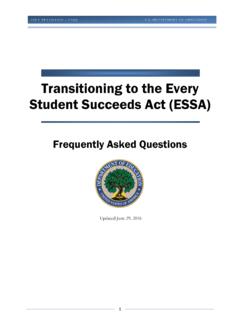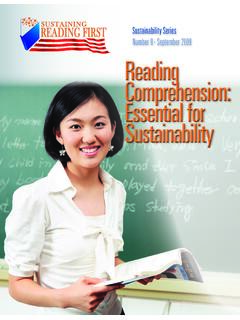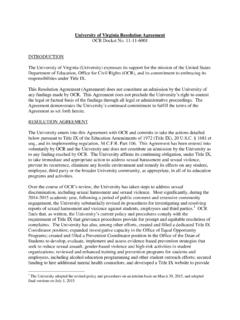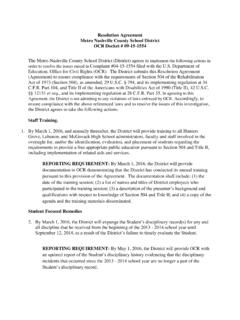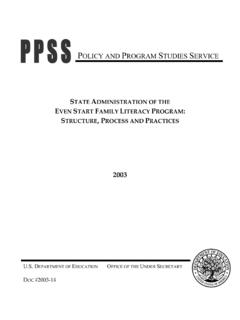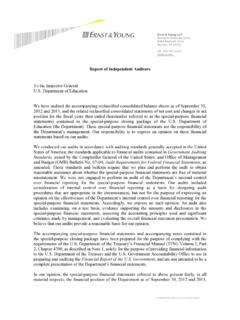Transcription of Developmental Education in Community Colleges
1 Developmental Education in Community Colleges Thomas Bailey and Sung-Woo Cho Community College Research Center When students arrive to enroll in Community college students who do not enroll in any college, almost all are asked to take a skills Developmental Education course complete a assessment in math, reading, and writing. degree or certificate in the same time Based on these assessments, students are either It will be very difficult to meet the Obama categorized as college-ready and can enroll administration's goal of increasing the number in college-level classes in the relevant of Community college graduates by 5 million subjects.
2 Or they are considered by 2020 without making significant progress Developmental or remedial students and on improving outcomes for students who are referred to academic services designed to arrive at Community Colleges with weak raise their skills up to college standards. Many academic skills. students are referred to multiple levels of remediation up to five levels in some cases. In this Brief we first report on evidence about This means that such students would have to the effectiveness (or, unfortunately, in too successfully navigate five semesters of pre- many cases, the ineffectiveness) of college instruction before being prepared for remediation and then provide information their first college-level course.
3 About the progression of students through the Developmental sequence. We discuss problems While a variety of other remedial services are associated with the crucial assessments and offered, the large majority consists of these make a brief statement about costs. We then semester-long Developmental classes in the describe three initiatives designed to improve subjects to which students have been referred. the performance of remedial services. About 60 percent of incoming students are referred to at least one Developmental This is often surprising to them since the large Effectiveness majority of Community college entrants are high school graduates.
4 And for many, Do the services provided to students through remediation is not just a course, but rather, for Developmental Education programs work to those referred to multiple levels, a whole improve student outcomes? Given the size and curriculum. importance of the Developmental function, there are surprisingly few rigorous Addressing the needs of Developmental evaluations, and outcomes from those are not students is perhaps the most difficult and most encouraging. Two rigorous studies, one in important problem facing Community Colleges .
5 Florida and one in Texas, found that students Developmental students face tremendous who participated in remediation did no better barriers. Less than one quarter of Community on several outcome measures than similar college students who enroll in Developmental students who enrolled directly in college-level Education complete a degree or certificate courses. 3 On the other hand, a study in Ohio, within eight years of enrollment in college. In using a more restricted sample, found positive comparison, almost 40 percent of Community effects for math remediation but none for 46.
6 Reading. 4 But the results of these studies are recruits students to enroll in the first place, that most reliable for referred students whose improves the teaching that takes place in the assessment scores put them close to the remedial classroom in order to retain students remediation cutoff points that is, these were in the courses, and that helps students bridge among the stronger of the students who were the gap between courses. referred to Developmental Education . We know very little about the effectiveness of Of course the best Developmental Education Developmental Education for students who program is the one that avoids the need for score well below the cutoff score, although a remediation in the first place.
7 Certainly K12. study of a program for students in adult basic reform will help, but students will continue to skills classes in Washington State the I- arrive needing help (many Community college BEST program does show promising early students have been out of school for several outcomes. This will be discussed in more years or were schooled in their home detail below. countries). Intensive bridge programs that take place in the summer before college starts have the potential to make up for weaknesses and Progression allow students to start college at the college level.
8 Analysis of the progression of students through Developmental Education provides Assessments some insight into why these students are unlikely to go on to complete a degree or other Problems with the assessments (often called credential. Using student data from Colleges placement tests) used to refer students participating in the nationwide Achieving the represent another barrier to improved Dream initiative outcomes for students with weak academic ( ), we skills. Overall, there is no consensus about found that many students do not complete their what constitutes preparation for college.
9 States sequences of Developmental courses, and a and institutions use many different sizeable proportion of those referred never assessments, and even when they use the same even enroll. 5 To take math Developmental assessments, they often set different cutoff Education as an example, 28 percent of those scores. Moreover, there is no obvious point of referred did not enroll. Another 30 percent discontinuity in the distribution of cutoff failed or withdrew from one of the scores that might provide a meaningful point Developmental courses in which they enrolled.
10 To distinguish between remedial and Ten percent dropped out of their college-ready students. Thus, there is little Developmental sequences without ever failing to differentiate students within the wide range a course. Thus, only 31 percent successfully of students above and below the cutoff scores. completed their sequences of math remediation. Of those completers, about half Moreover, students who are referred to (16 percent of all of those referred) actually Developmental courses through the completed a college-level course in math assessments face many different problems.

